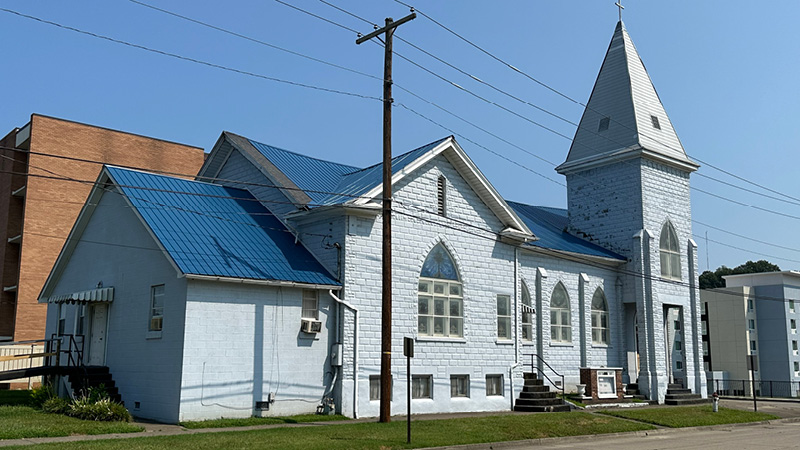Community members work to preserve legacy of Quinn Chapel
Published 5:00 am Wednesday, August 7, 2024

- Quinn Chapel African Methodist Episcopal (AME) Church
By Terry L. Hapney, Jr.
The Ironton Tribune
Efforts to retain the Quinn Chapel AME Church building to preserve its long legacy continue thanks to the work of a nonprofit organization composed of citizens in the Ironton community.
Rich Donohue, a member of the Quinn Chapel Historical Center, said Quinn Chapel was the first African American church in Ironton.
“A lot of people who went there were involved in the Underground Railroad, assisting slaves during that period of time to cross that river to head north to Canada or wherever else they were heading,” Donohue said.
Donohue referenced the research of Chris Saunders, a lifelong resident of Burlington, veteran of the U.S. Air Force who serves as an outreach specialist for the National Park Service and on the Appalachian Regional Commission Freedom, Heritage and Tourism Power grant committee. The goal of this organization is to research, identify and document 27 locations of the Underground Railroad in West Virginia, Kentucky and Ohio.
“Quinn Chapel is very historic,” Donohue said. “It closed last fall due to membership. It’s an historic church that is part of the church walk that the Museum does during the fall.”
The church’s history, according to Saunders’ research, dates to 1856 when Rev. Arthur Harwell, a minister of the Methodist faith, gathered with Mr. and Mrs. Gilbert Holt, Mr. and Mrs. Henry Harvey, Mrs. Gabriel Johnson, Mrs. Jane Pogue and other men and women who met at the Harvey home at 313 S. Seventh St. Two white friends, Rev. John Kelly and Mr. John Raine, assisted the group.
Throughout a series of important events—including fundraising, land purchases, organization of the first African American school in Ironton, construction of a new building, the naming of the church in 1868 after Bishop William Paul Quinn, the building of a parsonage, work done by James W. Taylor and Carter Woodson (most likely the same man who is the father of Black History Month) and a ground-breaking ceremony with the laying of the cornerstone—Quinn Chapel became an “integral part of the Ironton community.”
Donohue said after the church closed, he contacted Saunders when the building was for for sale. They organized a meeting held this past January.
“We asked if Quinn Chapel could be a project similar to the John Gee project to the Black, historical church in Gallipolis,” Donohue said. “The answer was ‘no; the bishop is selling it.’”
The John Gee Black Historical Center “is a cultural and educational center” that focuses on ensuring “the preservation of tradition, culture, crafts, music and art of the African Americans in Southeastern Ohio and to educate our diverse people about African American traditions and about the past and present contributions of African Americans to this country,” according to the John Gee Black Historical Center website.
Donohue sent a letter to the bishop a few weeks later.
“We’re interested in preserving the legacy of the church,” Donohue said. “We sparked some interest. He wanted to meet with us.”
The meeting, held at Ohio University Southern, saw approximately 100 people attend from throughout the community.
Donohue explained that Andrew Feight, Ph.D., professor of American and public history and director of the Center for Public History at Shawnee State University, and Cicero Fain, Ph.D., assistant provost of inclusive excellence and diversity, equity and inclusion fellow at Marshall University, “have taken an interest in it.”
“They’re working on the Underground Railroad with the National Park system,” Donohue said. “This is one of those locations. It’s not 100% done, but it’s one of the points that they want to make under the Underground Railroad part.”
The nonprofit also met at the church with the bishop. Donohue said the purpose of the nonprofit was to get the church organization to donate the church.
“We did get an answer that said we’re willing to work with you but we’re not going to donate the church,” Donohue said.
Right now, the nonprofit has a lease agreement that members composed and sent to the bishop.
“Hopefully, we will get some type of reply back,” Donohue said.
The Quinn Chapel Historical Center is a multicultural concept, using a church focusing on Black history.
“The church started with many Black individuals and a few white friends,” Donohue said. “We’re looking to have events there and some type of worship service monthly there. They’d like to see a minister there preaching at least monthly.”
With the nonprofit’s plans not finalized, there is hope to create a museum in the building.
“It would also serve as a place for people to have meetings,” Donohue said. “With the Gateway project—reaching out—a visitors center where people could stop in and pick up pamphlets…It could tell people about other parts of Ironton and Lawrence County.”
The lease isn’t finalized, according to Donohue. He emphasized that similar to the Ironton-Lawrence County Memorial Day Parade committee, an organization in which he serves, “If we don’t work on it and continue it, it could fade away.”
Donohue anticipates it could take additional time before the bishop and church organization finalize their proposal to send back for the members of the Quinn Chapel Historical Center to consider.
“It has to be good for both organizations or it’s not good for anybody,” Donohue said.





